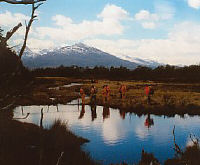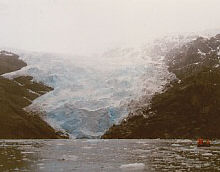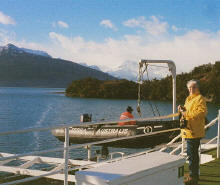
Glacier snout reaches the water
![]()
Chile’s wild west fiordland coast is a fascinating region of unique natural beauty. Virgin territory abounds and yet you can enjoy the sights from the comfort of a luxury cruise ship.
Every Saturday evening the ship Terra Australis sets off with up to 114 passengers from the Chilean port of Punta Arenas on the Strait of Magellan at the southern tip of South America and, after a week of cruising the fiords and channels of the island of Tierra del Fuego, it returns to repeat the performance!
The strait was discovered in 1520 by the Portuguese navigator Ferdinand Magellan whilst pioneering a route to the East Indies for the King of Spain. His sailors sighted bonfires tended by the Ona Indians on the land to the south, which they called Tierra del Fuego, the land of fire.
Here, the great Andean mountain chain makes its final appearance in the southern part of the island, as the Cordillera Darwin (to 2500 metres) and ice field. This is the remnant of a huge ice sheet that existed during the last Ice Age, some 100,000 years ago. The melting of the ice has revealed a magnificent, glacier-sculptured rocky landscape. Rising sea has flooded valleys, creating a maze of channels, islands and fiords where glaciers descend into the water, shedding icebergs.
Off We Go
I did this cruise with my Canadian friend Ruth, from Montreal, during the last week of October, still in the low season, and braved the inclement weather. The wind was so strong our departure was delayed until 11 pm, requiring a tug to pull the ship off the wharf. In darkness, we were buffeted across the Strait of Magellan and entered the calmer waters of Almirantazgo Sound.
Excerpts from my travel journal follow: “Each day there are one or two shore excursions going by Zodiac rubber boat, each taking 15 passengers. An expert multi-lingual guide accompanies you. This first morning we don our orange lifejackets and yellow waterproof pants and jacket, all expectant, hoping not to scare the local animal life by our weird appearance!

A beaver pond
![]()
“Landfall is at Ainsworth Bay, on a stony beach with nesting skua gulls. Close by dozes an enormous elephant seal with cubs. We quietly move off over the squaggy peat mosses into the Magellan forest of southern beech trees (lengas and coihues), liberally festooned with “Old Man’s Beard” lichen. We skirt a swampy lake dammed by beavers. None were sighted, but their telltale chewed-off tree stumps were everywhere.
“Our chattering return to the beach causes the “heffalump seal” to head for the water. Like an enormous slug, its massive body wriggles its way to safety with cubs following. Cameras click and we relax awhile enjoying the hot chocolate or whisky and ice provided as refreshment by the crew.”
Los Glaciares
“Next morning at 6 am the ship’s intercom awoke us to suggest coming up on deck to view the d’Agostini Glacier before getting under away! Unbeknown to us the ship had, during the night, cruised through a maze of channels to finally drop anchor at the head of a narrow fiord cluttered with icebergs.

Condor Glacier reaches the sea
![]()
“Black slopes tower above us. A 40 metre wall of ice seems too close for comfort. We watch and listen, fascinated. First the awesome silence, then comes weird creaks and groans of creeping ice, culminating in a tremendous boom and shower of ice dust as a huge chunk splashes into the water, sending waves towards us. The ship’s engines start up and I am thankful to retreat from this scary place to calm myself over a leisurely breakfast of bacon and eggs.
“We head along another fiord to see the Condor Glacier. The weather is foul and sea choppy. The Zodiac trip is cold and wet. We dodge tiny ice flows which get bigger and more frequent the closer to the glacier. I am not happy, having seen the size of the waves generated by even a small ice fall! Also, I wonder what happens if our rubber boat gets ripped open by floating ice, which is as hard as a rock? Very exciting indeed! Even Charles Darwin in his long boat explorations here in 1833 nearly came to grief.
“We admire another awesome glacier snout from our rubber boat…fantastic, but let’s get out of here fast! At last, retreat, glorious retreat, to a sandy beach and whiskey on the rocks to warm up, and await transport back to the mother ship away distant through the fluttering snow.”
Fabulous Food!

Spider crabs for dinner
![]()
“The choppy sea gave us a bouncy, wet, Zodiac trip back to the ship anchored out in the channel. Once on board and stripped of our waterproofs, we all enjoy a bowl of steaming chowder and chat of our adventure ashore. Our attention is attracted to a fishing boat battling the waves and heading towards us. A rendezvous with the fishermen results in our crew hauling aboard several sacks of spider crab, or centollas, destined to be served up for dinner, fresh from the icy sea. Almost too fresh, for one a metre across the legs, is displayed alive on ice, to greet the diners on arrival!”
Overall the meals were superb and often featured delicacies of the region, including salmon dishes, traditional Chilean stews of fish (curanto), and beef or chicken (pastel de choclo), together with great empanadas, or pasties with a savoury filling of chicken, beef or shellfish. The excellent Chilean wine supply was never-ending at lunch and dinner.
Being October, one month after the terrorist attacks in the US, the passenger list was almost devoid of North Americans, being composed predominantly of Latinos from Chile, Mexico and Brazil. Onboard entertainment was extensive. At any time you could visit the bridge and be briefed on the navigation situation at hand. During the day lectures were held on the wildlife, history and geography of the area. Also enjoyable were cookery demonstrations and cocktail making. In the evening we had a fashion parade, karaoke, a penguin night and dancing till midnight.
Along the Beagle Channel

Cruising the Beagle Channel
![]()
“Daybreak on the third morning found us cruising the Beagle Channel along the Avenue of Glaciers towards Yendagaia Bay; somewhat faster than Captain Fitzroy in his survey vessel HMS Beagle, in 1832! His charts of the region allow us easy and safe passage today.
“Glaciers Italia, Frances, Holandes and more, one after the other, tumble their ice directly into the Beagle Channel. Interspersed are gloomy narrow fiords cluttered with icebergs calved from the glacier fronts existing deep within the mountains.
“After an excursion at Yendagaia Bay visiting a sheep ranch or estancia we head on to Puerto Williams, the world’s most southern town, located on tiny Isla Navarino bordering the Beagle Channel. Our ship moors next to a Chilean frigate waiting to go into action, which nowadays is more likely helping a yacht in distress at Cape Horn. Puerto Williams is primarily a naval base with the minimum of tourist infrastructure. The attractions are unspoiled Nature and a 1930’s style village quaintness.
“The passengers brave the cold wintry day to explore on foot the desolate town, poking curiously into the few dilapidated little shops on the plaza. Next we head off to visit the recommended Martin Gusinde Museum, a tiny building housing a valuable collection of photographs of the now vanished Ona and Yamana Indians, the original inhabitants of Tierra del Fuego.

Ruth and Allano at the Yacht Club bar
![]()
“Rain is threatening, so we hurry down to the shoreline heading for the Yacht Club, which occupies the top decks of a sunken freighter accessed by a permanent jetty. The cosy open fire and bar are a welcome sight. Soon locals, yachties, naval officers and tourists mingle together in friendly banter.
“The Micalvi Club de Yate is unique geographically, being 100 kms from Cape Horn. It is a favoured provisioning stopover for cruising between the Pacific and Atlantic Oceans, the fiords of Tierra del Fuego and Chile, as well as south to Antarctica! Strange it is to watch a departing yacht having several sheep carcasses strung to the yardarm.”
Argentina Here We Come!
“Next morning we arrive at the Argentine port of Ushuaia, blanketed with snow. The jagged mountainous backdrop impresses us. The blue sky and crisp sea air is invigorating. We explore the city, poking into all the touristy shops along Avenida San Martín, and are surprised at the variety and high quality of their souvenir goods.”

Car ferry at the Strait of Magellan
![]()
The Terra Australis dropped off passengers and gained some more for the return trip to Punta Arenas. We stayed two nights in Ushuaia and returned to Punta Arenas by bus, which is taken across the Strait of Magellan by car-ferry. An anticlimax to travel by bus you may think? Not so! We had experienced such concentrated excitement for four days, it was comforting to relax and reflect on our adventures.
Checklist
The Terra Australis cruise from Punta Arenas to Ushuaia costs a minimum of $US785, which includes four nights on board, a B-Class cabin, double occupancy, low season (April-Oct). Similar arrangement high season (mid Dec-Feb) costs $US1244. For details, bookings and payment, consult their office in Santiago de Chile, or their web site.
For accommodation and transport in Chile, check out the following tourist web sites: Chip Travel and Chile Discover.
Questions?
If you want more information about this area you can email the author or check out our South America Insiders page.